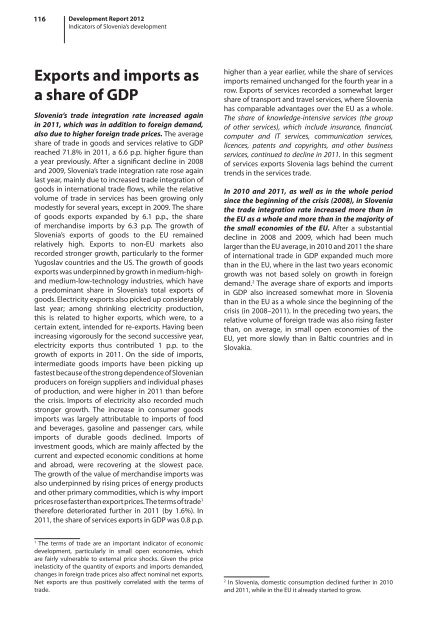development report 2012 - UMAR
development report 2012 - UMAR
development report 2012 - UMAR
You also want an ePaper? Increase the reach of your titles
YUMPU automatically turns print PDFs into web optimized ePapers that Google loves.
116 Development Report <strong>2012</strong><br />
Indicators of Slovenia’s <strong>development</strong><br />
Exports and imports as<br />
a share of GDP<br />
Slovenia’s trade integration rate increased again<br />
in 2011, which was in addition to foreign demand,<br />
also due to higher foreign trade prices. The average<br />
share of trade in goods and services relative to GDP<br />
reached 71.8% in 2011, a 6.6 p.p. higher figure than<br />
a year previously. After a significant decline in 2008<br />
and 2009, Slovenia’s trade integration rate rose again<br />
last year, mainly due to increased trade integration of<br />
goods in international trade flows, while the relative<br />
volume of trade in services has been growing only<br />
modestly for several years, except in 2009. The share<br />
of goods exports expanded by 6.1 p.p., the share<br />
of merchandise imports by 6.3 p.p. The growth of<br />
Slovenia’s exports of goods to the EU remained<br />
relatively high. Exports to non-EU markets also<br />
recorded stronger growth, particularly to the former<br />
Yugoslav countries and the US. The growth of goods<br />
exports was underpinned by growth in medium-highand<br />
medium-low-technology industries, which have<br />
a predominant share in Slovenia’s total exports of<br />
goods. Electricity exports also picked up considerably<br />
last year; among shrinking electricity production,<br />
this is related to higher exports, which were, to a<br />
certain extent, intended for re-exports. Having been<br />
increasing vigorously for the second successive year,<br />
electricity exports thus contributed 1 p.p. to the<br />
growth of exports in 2011. On the side of imports,<br />
intermediate goods imports have been picking up<br />
fastest because of the strong dependence of Slovenian<br />
producers on foreign suppliers and individual phases<br />
of production, and were higher in 2011 than before<br />
the crisis. Imports of electricity also recorded much<br />
stronger growth. The increase in consumer goods<br />
imports was largely attributable to imports of food<br />
and beverages, gasoline and passenger cars, while<br />
imports of durable goods declined. Imports of<br />
investment goods, which are mainly affected by the<br />
current and expected economic conditions at home<br />
and abroad, were recovering at the slowest pace.<br />
The growth of the value of merchandise imports was<br />
also underpinned by rising prices of energy products<br />
and other primary commodities, which is why import<br />
prices rose faster than export prices. The terms of trade 1<br />
therefore deteriorated further in 2011 (by 1.6%). In<br />
2011, the share of services exports in GDP was 0.8 p.p.<br />
higher than a year earlier, while the share of services<br />
imports remained unchanged for the fourth year in a<br />
row. Exports of services recorded a somewhat larger<br />
share of transport and travel services, where Slovenia<br />
has comparable advantages over the EU as a whole.<br />
The share of knowledge-intensive services (the group<br />
of other services), which include insurance, financial,<br />
computer and IT services, communication services,<br />
licences, patents and copyrights, and other business<br />
services, continued to decline in 2011. In this segment<br />
of services exports Slovenia lags behind the current<br />
trends in the services trade.<br />
In 2010 and 2011, as well as in the whole period<br />
since the beginning of the crisis (2008), in Slovenia<br />
the trade integration rate increased more than in<br />
the EU as a whole and more than in the majority of<br />
the small economies of the EU. After a substantial<br />
decline in 2008 and 2009, which had been much<br />
larger than the EU average, in 2010 and 2011 the share<br />
of international trade in GDP expanded much more<br />
than in the EU, where in the last two years economic<br />
growth was not based solely on growth in foreign<br />
demand. 2 The average share of exports and imports<br />
in GDP also increased somewhat more in Slovenia<br />
than in the EU as a whole since the beginning of the<br />
crisis (in 2008–2011). In the preceding two years, the<br />
relative volume of foreign trade was also rising faster<br />
than, on average, in small open economies of the<br />
EU, yet more slowly than in Baltic countries and in<br />
Slovakia.<br />
1<br />
The terms of trade are an important indicator of economic<br />
<strong>development</strong>, particularly in small open economies, which<br />
are fairly vulnerable to external price shocks. Given the price<br />
inelasticity of the quantity of exports and imports demanded,<br />
changes in foreign trade prices also affect nominal net exports.<br />
Net exports are thus positively correlated with the terms of<br />
trade.<br />
2<br />
In Slovenia, domestic consumption declined further in 2010<br />
and 2011, while in the EU it already started to grow.
















